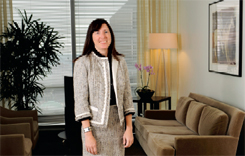Beyond the Quads
Full Circle
The career path of Allegra Rich, AB’92, led her away from the law to nonprofit management—and then back to a new role at her original firm.
During her first decade of work at the Chicago law firm Seyfarth Shaw, Allegra Rich, AB’92, achieved an enviable level of success. In 2001 she made the Law Bulletin’s list of “40 Illinois Attorneys under 40 to Watch.” In 2003 she made partner. In 2005 she was listed among the “Illinois Super Lawyers” in the magazine of that name.
There was just one problem: Rich dreaded going to work. She had come to realize that the very thing that made her so good at her job was also was making her miserable.
At Seyfarth, Rich specialized in employment discrimination and litigation involving the Employee Retirement Income Security Act—in particular, ERISA class-action suits. “I would get very personally invested in the cases,” she says. “That made me an excellent advocate for my client, but it took too much of a personal toll.” Although some attorneys could shake off nasty letters or other unpleasant tactics (the decreasing level of civility in the law is a big conversation topic among lawyers, Rich says), she could not. Rich disliked the “hand-to-hand combat that in some ways is the essence of being a litigator.”
In 2005 Rich took an unusual step for a lawyer in such a senior position: she quit. Deeply loyal to Seyfarth, where she had started her career in 1994 as a summer associate, she did not even consider changing firms. She also did not want to take a leave of absence, because she genuinely believed she would never be back. Instead Rich, who had wanted to be a lawyer like her mother since the third grade, took a year off to consider her options.
Her yearlong sabbatical turned into 15 months, and—to the amazement of her former colleagues— she didn’t experience a single moment of boredom. She took courses in Russian and manuscript editing. She traveled to the Pacific Northwest, Paris, and Beijing. She watched tennis at Wimbledon and the 2006 Winter Olympics in Turin, Italy. She trained to be an adult-literacy volunteer.
Rich also served on the University of Chicago Women’s Board, where she helped oversee grant proposals. She enjoyed the process so much, she signed up for a few Graham School classes in nonprofit management, thinking she might try to find a job at a foundation.
When Seyfarth’s managing partner, J. Stephen Poor, heard of Rich’s new interest in philanthropy, he had a novel suggestion. The firm wanted to improve its efforts in pro bono legal work, community service, and charitable giving. Perhaps all three could be combined into one job with her name on it.
Rich was intrigued. For the final project in her second Graham School course, Performance Management in Nonprofit Organizations, she helped define the position and laid out the business case for adding it to the firm. The project won Rich not only an A from instructor Gordon Medlock but a groundbreaking role at Seyfarth. In January 2007 Rich returned as the firm’s first pro bono and philanthropy partner.
In this position, Rich organizes the firm’s pro bono programs in its nine offices throughout the United States. Previously, lawyers who were interested in pro bono work often didn’t know how to go about finding cases. Now lawyers are given institutional support, as well as up to 200 hours of billable credit for pro bono—more than 10 percent of the total, 1950 hours each attorney must bill per year. (Rich admits that during her time as a litigator at Seyfarth, she did very little pro bono work, mainly because her time was completely taken up by her main caseload.) In 2007 the firm did more than 23,000 hours of pro bono work, up 81 percent from 2006.
Rich has also brought an overall strategic order to the firm’s community service and charitable programs. Each office has been encouraged to adopt one or two flagship charities to support; Chicago, for example, has chosen the American Cancer Society and the American Heart Association. Rich also oversees the Seyfarth Shaw Charitable Foundation, which gives out grants on behalf of the firm. In 2009 Rich will add a fourth part to her role: “Go Green,” an effort to make Seyfarth’s offices more environmentally sustainable. Double-sided printing, deskside paper recycling, and bicycle-storage and shower facilities are all part of her plan.
An increased emphasis on pro bono work is a growing trend among law firms, but Rich’s role is still out of the ordinary. When she was appointed, the Chicago Daily Law Bulletin reported that an estimated 30 law firms across the country had a fulltime pro bono partner with no paying clients. And as far as Rich is aware, no other firm has one person in charge of pro bono, community service, and charitable giving. “I believe that we continue to be innovative in that regard,” she says.
Rich never did get to take the third course in the nonprofit management series at the Graham School. She was enrolled, but—in one of the few blemishes on her academic/career record—had to take an incomplete. “By that time,” she says, “I was already on my way back to work.”—Carrie M. Golus, AB’91, AM’93
